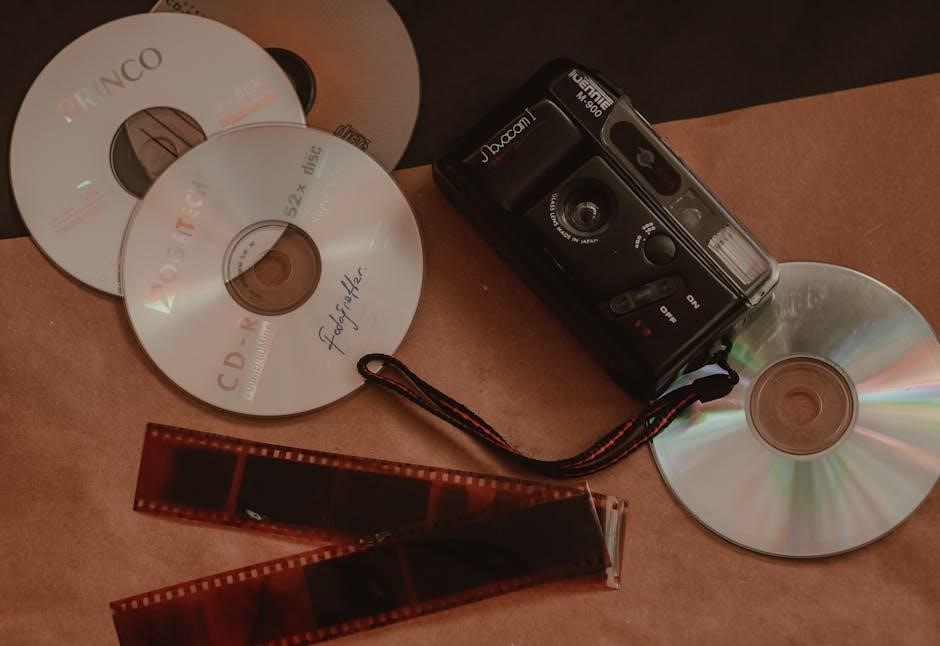The Source Audio Collider DelayReverb is a powerful stereo effects pedal combining 12 handpicked delay and reverb engines from Nemesis and Ventris pedals, offering versatile soundscaping capabilities․
1․1 Overview of the Source Audio Collider
The Source Audio Collider is a versatile stereo delay and reverb pedal designed for musicians seeking rich, immersive soundscapes․ It combines 12 handpicked delay and reverb engines from Source Audio’s award-winning Nemesis Delay and Ventris Dual Reverb pedals․ The Collider offers pristine 56-bit processing for high-quality audio and features dual effects that can be used independently or in tandem․ With its intuitive controls and MIDI compatibility, the pedal provides deep customization options․ It is part of the Source Audio One Series, known for its robust construction and user-friendly design; Whether for subtle ambiance or complex sound designs, the Collider is a powerful tool for guitarists and audio enthusiasts alike․
1․2 Key Features of the Collider DelayReverb
- 12 Handpicked Engines: Combines delay and reverb engines from the Nemesis Delay and Ventris Dual Reverb pedals, offering a wide range of tonal possibilities․
- 56-Bit Processing: Ensures high-quality, pristine audio with minimal noise and artifact interference․
- Dual Effects Capabilities: Run delay and reverb simultaneously or independently for complex soundscapes․
- MIDI Compatibility: Allows for external control and integration with MIDI controllers for advanced functionality․
- Expression Pedal Input: Enables real-time control over parameters for dynamic performances․
- 128 Preset Recall: Save and recall custom settings easily using the Neuro Hub or MIDI controller․
- Stereo Processing: Provides immersive, three-dimensional audio for enhanced spatial effects․
The Collider DelayReverb is designed to deliver unmatched versatility and sonic exploration for guitarists and audio enthusiasts․
Getting Started with the Source Audio Collider
Getting started with the Source Audio Collider involves unboxing, initial setup, powering the pedal with the included 9V DC supply, and connecting it to your guitar rig․ These steps ensure a seamless integration into your setup․
2․1 Unboxing and Initial Setup
Welcome to the Source Audio Collider! Upon unboxing, you’ll find the Collider pedal, a 9V DC power supply, a quick reference guide, and a warranty card․ Inspect the pedal for any damage and ensure all items are included․ Before powering on, locate the DC 9V input on the back panel․ Using the provided power supply is recommended to avoid damage․ Connect the pedal to your guitar rig using a standard 1/4-inch cable․ For initial setup, ensure the pedal is in bypass mode to test the signal chain․ If using an external footswitch, refer to the manual for compatibility details․ Familiarize yourself with the controls and knobs before powering on․ This ensures a smooth and trouble-free experience; The Collider is now ready to enhance your soundscapes․
2․2 Powering the Pedal
To power the Source Audio Collider, use the included 9V DC power supply, ensuring it is connected to the DC 9V input on the back panel․ Avoid using non-Source Audio supplies, especially unregulated ones, as they may damage the pedal․ The Collider is designed to operate efficiently with the provided adapter, delivering consistent power for its 56-bit processing and dual effects capabilities․ Never reverse the polarity or use incorrect voltage, as this can cause permanent damage․ Proper power supply ensures optimal performance and sound quality․ Always refer to the manual for specific power requirements and safety guidelines to maintain the integrity of your pedal․
2․3 Connecting the Pedal to Your Guitar Rig
Connect your guitar to the Collider using a standard 1/4-inch mono or stereo cable․ The input jack is located on the front panel, while the output jack is on the back․ For mono operation, use a TS cable, or for stereo, use a TRS cable to access the pedal’s stereo capabilities․ Ensure the pedal is powered on before connecting to your rig․ Additional connectivity options include MIDI for external control and an expression pedal input for real-time parameter adjustments․ The Collider supports external footswitches via 1/4-inch TRS or 1/8-inch TRRS connections, allowing for expanded functionality․ Proper connection ensures optimal signal flow and sound quality, making it easy to integrate the Collider into any guitar setup․

Understanding the Delay and Reverb Engines
The Collider features 12 handpicked delay and reverb engines, including vintage Spring, Plate, and Hall reverbs, as well as advanced algorithms like Shimmer and Swell, offering diverse sonic textures․
3․1 Overview of the 12 Handpicked Engines
The Source Audio Collider DelayReverb is equipped with 12 meticulously crafted delay and reverb engines, carefully selected from the award-winning Nemesis Delay and Ventris Dual Reverb pedals․ These engines include a variety of delay types, such as analog, tape, and digital delays, as well as an array of reverb options like Spring, Plate, Hall, and more exotic choices like Shimmer and Swell․ Each engine has been fine-tuned to deliver exceptional audio quality and versatility, allowing musicians to explore a wide range of tonal landscapes․ The combination of these engines in one pedal provides unparalleled flexibility for creating complex soundscapes, making the Collider a powerful tool for both live performance and studio recording․
3․2 Delay Engines: Types and Configurations
The Source Audio Collider DelayReverb features five distinct delay engines, each with its own unique sonic characteristics․ The Digital Delay engine delivers crystal-clear, modern repeats with precise control over timing and feedback․ The Analog Delay offers warm, vintage-inspired tones reminiscent of classic tape delays․ The Tape Delay engine simulates the nostalgic sound of analog tape machines, with natural saturation and decay․ The Dubecho engine combines two independent delays for rich, layered soundscapes, while the Reverse Delay plays back repeats in reverse for creative, otherworldly effects․ Each delay engine is highly configurable, allowing users to tweak parameters such as delay time, repeats, and mix level to suit their musical needs․ This versatility makes the Collider DelayReverb a go-to tool for a wide range of musical genres and applications․
3․3 Reverb Engines: Types and Configurations
The Source Audio Collider DelayReverb is equipped with seven meticulously crafted reverb engines, offering a diverse range of spatial effects․ The Spring Reverb mimics the classic metallic tones of vintage spring tanks, while the Plate Reverb delivers smooth, lush ambiance reminiscent of iconic studio plate reverbs․ The Hall Reverb provides expansive, natural room-like decay, perfect for creating grand, atmospheric soundscapes․ Additionally, the Collider features more experimental reverbs, such as Shimmer, E-Dome, and Swell, which introduce ethereal, otherworldly textures․ Each reverb engine is fully customizable, with adjustable parameters like decay time, pre-delay, and mix level, allowing users to tailor the spatial effects to their musical vision․ This variety ensures the Collider can handle everything from subtle ambiance to immersive, experimental sound design․

Customizing Your Sound
The Collider DelayReverb offers extensive customization options, allowing users to tweak knobs for real-time adjustments and utilize the Neuro Editor for deep parameter control and preset management․
4․1 Adjusting the Knobs and Controls
The Source Audio Collider DelayReverb features intuitive knob-based controls for real-time sound customization․ Users can adjust parameters such as delay time, feedback, and reverb level directly․ Each knob provides precise control over key aspects of the delay and reverb engines, allowing for dynamic tweaking․ The pedal’s design ensures that adjustments are made seamlessly, with clear visual feedback․ Additionally, the Collider enables saving these customizations as presets for quick recall during performances․ This hands-on approach empowers musicians to craft unique tones tailored to their artistic vision, making it a versatile tool for both studio and live settings․ The knobs’ responsiveness and the pedal’s ergonomic layout enhance the overall user experience, ensuring effortless sound shaping․
4․2 Using the Neuro Editor for Deep Customization
The Neuro Editor software offers unparalleled control over the Source Audio Collider, enabling users to craft intricate delay and reverb configurations․ With its intuitive interface, musicians can dive into advanced parameters, tweaking every aspect of their sound․ The editor allows for the creation of custom presets, which can be easily organized and recalled․ Real-time adjustments and visual feedback make fine-tuning a breeze․ Additionally, the Neuro Editor facilitates sharing and downloading user-created presets, fostering a community-driven approach to sound design․ This powerful tool transforms the Collider into a highly adaptable effects processor, perfect for both studio experimentation and dynamic live performances, ensuring that every artist can unlock their unique sonic vision․
4․3 Saving and Recalling Presets
Saving and recalling presets on the Source Audio Collider is a seamless process, allowing musicians to instantly access their favorite sounds․ The pedal offers ample storage for user-created presets, which can be saved directly on the device or via the Neuro Editor software․ Presets can be named and organized for easy navigation, making it simple to recall them during live performances or studio sessions․ Additionally, the Collider supports MIDI control, enabling preset changes with an external MIDI controller․ This feature-rich system ensures that your custom configurations are always at your fingertips, providing unparalleled flexibility and efficiency in your musical workflow․
MIDI Control and Connectivity
The Source Audio Collider supports MIDI control, enabling seamless integration with external devices for enhanced preset management and performance flexibility․
5․1 Understanding MIDI Implementation
The Source Audio Collider DelayReverb features robust MIDI implementation, allowing for precise control over presets, parameters, and scenes․ MIDI enables seamless communication between the pedal and external controllers or devices, enhancing live performance and studio workflows․ Users can assign MIDI channels to control various aspects of the pedal, such as switching between delay and reverb engines or adjusting effect parameters in real-time․ The Collider also supports MIDI clock synchronization, ensuring perfect timing alignment with other MIDI-compatible gear․ Additionally, MIDI messages can be used to recall specific presets or scenes, streamlining the user experience․ This advanced connectivity makes the Collider highly adaptable to complex rigs and multi-pedal setups, offering unparalleled control and flexibility for musicians․
5․2 Connecting External Footswitches
The Source Audio Collider DelayReverb supports external footswitches for enhanced control over its features․ Users can connect footswitches to enable bypass, preset navigation, and scene switching․ The pedal is compatible with passive single (TS 1/4 connection), dual (TRS 1/4 connection), or the Source Audio Tap Tempo footswitch (1/8 TRRS and 1/4 TRS connection)․ External footswitches allow for hands-free operation, making it easier to toggle effects, scroll through presets, or engage scenes during live performances․ This flexibility enhances the pedal’s usability in complex rigs, enabling musicians to access a wide range of functions without interrupting their workflow․ Proper connection ensures seamless integration and reliable performance, making external footswitches a valuable addition to the Collider setup․
5․3 Using the Neuro Hub for Multi-Pedal Scenes
The Source Audio Neuro Hub enables advanced multi-pedal scene management, allowing users to connect up to five compatible Source Audio pedals․ This central hub stores settings for up to 128 scenes, combining the power of multiple effects into a unified system․ Scenes can be saved and recalled using a standard MIDI controller, offering seamless transitions during performances․ The Neuro Hub simplifies complex pedalboard setups by organizing effects into customizable scenes, ensuring easy access to desired sounds․ It enhances the Collider’s functionality by integrating it with other Source Audio pedals, creating a cohesive and flexible effects ecosystem․ This feature is ideal for musicians seeking to streamline their rigs and elevate their live performances․

Advanced Features of the Collider
The Collider features 56-bit processing, stereo effects, and dual delay/reverb engines, offering high-quality sound and immersive sonic exploration with precise control and customization options․
6․1 Stereo Processing and Dual Effects
The Source Audio Collider DelayReverb features advanced stereo processing, allowing for immersive, three-dimensional soundscapes․ With dual effects engines, users can simultaneously run delay and reverb, each with independent stereo routing․ This setup enables complex, layered sound designs, from subtle ambiance to expansive experimental textures․ The stereo processing ensures that each effect is rich and spatially detailed, while the dual engines provide flexibility in creating unique sonic combinations․ Whether used for guitar, synthesizers, or other sources, the Collider’s stereo capabilities elevate the audio experience, offering depth and dimensionality that single-effect pedals cannot match․ This feature is a cornerstone of the Collider’s design, making it a versatile tool for musicians seeking rich, dynamic sound․
6․2 56-Bit Processing for High-Quality Sound
The Source Audio Collider DelayReverb utilizes dual 56-bit digital signal processing (DSP) engines to deliver exceptional sound quality․ This high-resolution processing ensures precise control over delay and reverb effects, maintaining clarity and definition even in complex soundscapes․ The 56-bit architecture minimizes digital artifacts and noise, providing a clean and transparent signal path․ This advanced processing power allows for intricate effect configurations without compromising audio fidelity․ Musicians can trust the Collider to preserve the integrity of their tone, whether creating subtle ambiance or dense, layered textures․ The combination of 56-bit processing and stereo capabilities makes the Collider a premium choice for discerning players seeking high-quality sound reproduction․ This feature underscores Source Audio’s commitment to sonic excellence and innovation in effects design․
6․3 Expression Pedal Compatibility
The Source Audio Collider DelayReverb is designed to work seamlessly with external expression pedals, offering real-time control over key parameters; This feature allows musicians to dynamically adjust delay time, reverb level, or other effects in the heat of a performance․ The expression pedal compatibility enhances the pedal’s versatility, enabling smooth transitions and expressive sound manipulation․ By connecting an expression pedal, players can access a wider range of tonal possibilities without needing to bend down to adjust knobs․ This hands-free control not only adds convenience but also elevates the Collider’s performance capabilities, making it a powerful tool for live gigs and studio sessions․ The expression pedal integration is a testament to Source Audio’s focus on delivering a user-friendly and adaptable effects platform․

Troubleshooting Common Issues
Address power supply issues by using the included 9V DC adapter․ Check connectivity by ensuring all cables are secure․ Resolve firmware update problems by following manual instructions carefully․
7․1 Resolving Power Supply Issues
To resolve power supply issues with the Source Audio Collider, ensure you use the included 9V DC adapter․ Avoid non-Source Audio supplies, as they may damage the pedal․ If the pedal doesn’t power on, check the DC 9V jack connection on the back panel․ Verify the adapter is properly plugged into both the pedal and the power source․ If issues persist, test the adapter with another device to confirm it’s functioning correctly․ Damage caused by unregulated or third-party adapters isn’t covered under warranty․ Always refer to the manual for power supply specifications to maintain optimal performance and avoid potential harm to the unit․
7․2 Fixing Connectivity Problems
To fix connectivity issues with the Source Audio Collider, start by ensuring all cables are securely connected to the correct inputs and outputs․ Check the guitar input, effects loop, and output connections for proper alignment․ If using MIDI, verify that the MIDI IN and OUT ports are connected correctly to your controller or other MIDI-compatible devices․ Consult the manual for connection diagrams and ensure you’re using the appropriate cables․ For external footswitches, confirm compatibility and proper TRS or TRRS connections․ If issues persist, reset the pedal by powering it off, then on again․ If problems remain unresolved, contact Source Audio customer support for further assistance or troubleshooting․
7․3 Addressing Firmware Update Problems
When encountering firmware update issues with the Source Audio Collider, ensure your computer recognizes the pedal․ Use the provided USB cable and install the latest version of the Neuro Editor software․ Restart the pedal and computer to establish a stable connection․ If the update fails, check for the latest firmware version on the Source Audio website and verify your internet connection․ Power cycle the pedal by disconnecting and reconnecting it to the computer․ If issues persist, reset the pedal to its default settings․ Consult the user manual for detailed firmware update instructions or contact Source Audio customer support for assistance․ Always use official Source Audio tools to avoid bricking the device․

Maintenance and Warranty Information
Regularly clean the pedal with a soft cloth and avoid harsh chemicals․ The Source Audio Collider is backed by a 2-year warranty covering defects in materials and workmanship․
8․1 Cleaning and Maintaining the Pedal
Regular maintenance ensures optimal performance of the Source Audio Collider․ Clean the pedal with a soft, dry cloth to remove dust and dirt․ Avoid harsh chemicals or abrasive materials, as they may damage the finish․ For stubborn marks, dampen the cloth slightly but ensure no moisture enters the pedal․ Store the Collider in a dry, cool environment to prevent damage from humidity or extreme temperatures․ Avoid exposing it to direct sunlight for extended periods․ Use the provided power supply to prevent damage from unregulated power sources․ Proper care extends the pedal’s lifespan and maintains its high-quality sound performance․
8․2 Understanding the Warranty Policy
The Source Audio Collider is backed by a 2-year warranty covering defects in materials and workmanship for pedals purchased from authorized dealers in the USA․ This warranty ensures repairs or replacements at no cost during the coverage period․ The warranty applies to the original purchaser only and does not cover damage from misuse, unauthorized modifications, or improper power supplies․ For international purchases, warranty terms may vary, so check with local distributors․ Register your pedal on the Source Audio website to validate your warranty․ Keep your purchase receipt as proof of ownership, as it is required for warranty claims․ This policy reflects Source Audio’s commitment to quality and customer satisfaction․

Resources and Support
The Source Audio Collider manual and additional resources are available online, including a user manual, quick reference guide, and access to the Source Audio Discord community․
9․1 Accessing the User Manual
The Source Audio Collider user manual is readily available for free download from the official Source Audio website and platforms like Manuals․co․uk․ The manual is provided in PDF format, ensuring easy access and readability․ It covers all essential features, setup instructions, and troubleshooting tips․ The document is available in English and has been rated by users, providing a reliable guide for optimizing the pedal’s capabilities․ Additionally, quick reference cards and MIDI implementation guides are included to enhance your understanding․ For further assistance, the Source Audio community and support team are accessible through their Discord server and official website, offering comprehensive resources to help you master the Collider DelayReverb․
9․2 Joining the Source Audio Community
Joining the Source Audio Community is an excellent way to connect with fellow musicians and sound enthusiasts․ The community is accessible via the official Source Audio Discord server, where members share tips, presets, and experiences․ By participating, you can engage in discussions, learn advanced techniques, and stay updated on new features and updates․ Additionally, the community provides a platform for troubleshooting and receiving support from both experienced users and Source Audio experts․ Being part of this close-knit group enhances your overall experience with the Collider DelayReverb, fostering creativity and collaboration․ Visit the Source Audio Discord to become a member and start exploring the full potential of your pedal․
9․3 Contacting Customer Support
For any inquiries or issues regarding the Source Audio Collider, the customer support team is readily available to assist․ You can contact them through the official Source Audio website or via email at support@sourceaudio․net․ The team is committed to providing prompt and helpful responses to ensure your experience with the Collider is trouble-free․ Additionally, the user manual and online resources offer comprehensive guidance, but if further assistance is needed, reaching out directly is encouraged․ Ensure to include details about your issue and any relevant setup information for a quicker resolution․ Source Audio also provides a two-year warranty for products purchased from authorized dealers, covering defects in materials and workmanship․ For more information, visit the Source Audio Support page․
The Source Audio Collider is a standout pedal offering 12 delay and reverb engines with stereo processing and dual effects, inspiring endless sonic exploration for musicians and creators․
10․1 Summary of the Source Audio Collider’s Capabilities
The Source Audio Collider DelayReverb is a versatile, high-quality stereo effects pedal designed for musicians seeking rich, immersive soundscapes․ It features 12 handpicked delay and reverb engines, carefully selected from Source Audio’s award-winning Nemesis Delay and Ventris Dual Reverb pedals․ With its intuitive interface and advanced customization options, the Collider offers seamless integration of delay and reverb effects, allowing for intricate sound design․ The pedal supports dual effects processing, enabling simultaneous use of delay and reverb for layered textures․ Its 56-bit processing ensures high-fidelity audio, while MIDI control and external footswitch compatibility expand its functionality․ Whether for studio recording or live performance, the Collider delivers exceptional sonic versatility and reliability, making it a valuable tool for guitarists and audio enthusiasts alike․
10․2 Future Updates and Potential Features
The Source Audio Collider DelayReverb is expected to evolve with future firmware updates, potentially introducing new delay and reverb engines, enhanced customization options, and improved MIDI functionality․ Users may anticipate additions like wireless connectivity or advanced preset-sharing capabilities․ Source Audio has a history of incorporating community feedback, suggesting that future updates could address user requests for expanded scene management or deeper integration with the Neuro Hub․ Additionally, new algorithms or effects types, such as advanced modulation or distortion, could be added to further enhance the pedal’s versatility․ As technology advances, the Collider may also see improvements in processing power or user interface design, ensuring it remains a cutting-edge tool for sound exploration․
